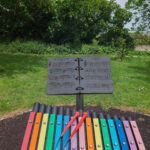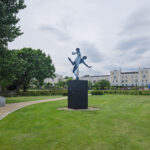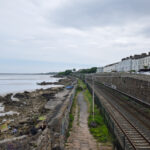PHOTOGRAPHED USING A FUJI GFX100RF
When I checked Google Maps this bridge is named Emily Burke Bridge After checking various sources, it appears that the name “Emily Burke Bridge” is not officially associated with the bridge in Limerick that carries the local road over the Park Canal. The bridge is consistently referred to in official documents and news reports as Park Road Bridge or Park Bridge. Based on the available information, there is a historical figure named Emily Burke, also known as Emily Weddall, who was a significant figure in Irish history. Born in 1867, she was a nurse who spent time in Russia before becoming an active member of the Gaelic League, Cumann na mBan, and a close friend of other notable figures like Maud Gonne and Kathleen Lynn. She was arrested during the 1916 Rising and is buried in a republican plot in Glasnevin Cemetery. However, there is no information linking her directly to the bridge in Limerick or suggesting she is the source of the name “Emily Burke Bridge.”
Back in 2012 I decided that I should locate and photograph all of the bridges in Limerick [see list below] but for various reasons I was unable to visit this bridge until 2017. Also, I was not 100% sure that it still existed because a local had told me that it had been demolished which just goes to prove that one cannot always depend on local knowledge. The false information may be due to the fact that the curve or height of the hump was reduced in 1960 in order to allow cars pass over the bridge. The bridge was originally configured to allow the passage of canal boats.
List of current bridges in Limerick city and nearby [not sure why the tunnel is considered to be a bridge]
1 Limerick Port Tunnel
2 Shannon Bridge – sometimes known as New Bridge, Whistling Bridge, Singing Bridge, Sighing Bridge.
3 Sarsfield Bridge
4 Thormond Bridge
5 Sylvester O’Halloran footbridge
6 Matthew Bridge
7 Baal’s Bridge – Original bridge at this site was called Ballsbridge
8 Abbey Bridge
9 Canal Bridge (Lock Quay Bridge)
10 O’Dwyer Bridge
11 Pa Healy Rd Bridge
12 Park Road Bridge / Park Canal Bridge
13 Guinness Bridge (Kevin Hannan Bridge)
14 Athlunkard Bridge
15 Black Bridge – footbridge
16 University Bridge
17 The Living Bridge / An Droichead Beo
18 Annacotty Bridge (original and new)
Limerick City has a fascinating collection of road bridges, including canal and railway bridges, which tell the story of the city’s expansion and development.
In the 1820s, a revival in trade after the Napoleonic wars led to the design of three new bridges by architects James and George Pain. These were part of a broader effort to improve the city’s connections with its valuable agricultural hinterland. The Athlunkard Bridge was completed in 1830, linking areas north and east of County Clare with the city centre and becoming a principal route to the west of Ireland. The narrow and decaying fourteenth-century Baal’s Bridge was rebuilt in 1831, creating an efficient single-span connection that significantly improved the route eastward to Dublin. The third was the Thomond Bridge, which replaced a series of medieval bridges and was rebuilt in 1840 using some of the original foundations.
Another notable structure is the Sarsfield Bridge, originally named Wellesley Bridge. Designed by Alexander Nimmo, it was built between 1823 and 1835. The bridge’s design was inspired by Paris’s Pont de Neuilly and it was renamed in 1882. The Mathew Bridge replaced the New Bridge in 1846 and connected the expanding Englishtown with the developing new town.
Further advancements included the Lock Quay Canal Bridge, a humpback bridge erected in 1757, which was restored by the Limerick Civic Trust. The railway bridge, built around 1860, carries the Corbally Road over the Limerick to Sligo railway line. An early example of a concrete bridge, the 1931 O’Dwyer’s Bridge, was built near the site of a previous bridge called Park Bridge.
The Story of Park Road Bridge
The Park Road Bridge is a single-span masonry arch bridge that crosses the Park Canal. Its construction date is unknown, but since the canal was completed in 1799, it is presumed the bridge was built around the same time.
In the 1960s, the original humpback masonry deck of the bridge was replaced with a steel-concrete composite deck to allow vehicles to pass over it more easily. Despite this, the original voussoir stones, spandrel walls, and parapets were retained. The bridge currently has a three-tonne weight restriction, and the area around it is a designated “Slow Zone” with a 30 km/h speed limit. Pedestrians, cyclists, and vehicles share the space, with traffic signals and speed ramps in place to manage safety.
Alternative to Park Road Bridge
In 2020, Limerick City and County Council announced a plan to build a new bridge to the east of the current Park Road Bridge. The planning application was approved in September 2021. The new bridge would connect Lower Park Road with Canal Bank, facilitating two-way traffic.
The existing Park Road Bridge would then be reserved exclusively for pedestrians and cyclists, with its traffic lights removed. The proposed works also include road widening on Canal Bank, new road surfacing, LED public lighting, and drainage improvements.
As of July 2025, there has been no further news or updates on the construction of the new bridge, which was a project included in the council’s 2024 funding allocation.
![PARK ROAD BRIDGE AND THE CANAL BANK AREA [LIMERICK JULY 2025]-254483-1](https://excellentstreetimages.com/TheFujiflimGFX100RFStreetPhotographer/wp-content/uploads/2025/07/PARK-ROAD-BRIDGE-AND-THE-CANAL-BANK-AREA-LIMERICK-JULY-2025-254483-1-1.jpg)
![PARK ROAD BRIDGE AND THE CANAL BANK AREA [LIMERICK JULY 2025]-254484-1](https://excellentstreetimages.com/TheFujiflimGFX100RFStreetPhotographer/wp-content/uploads/2025/07/PARK-ROAD-BRIDGE-AND-THE-CANAL-BANK-AREA-LIMERICK-JULY-2025-254484-1-1.jpg)
![PARK ROAD BRIDGE AND THE CANAL BANK AREA [LIMERICK JULY 2025]-254485-1](https://excellentstreetimages.com/TheFujiflimGFX100RFStreetPhotographer/wp-content/uploads/2025/07/PARK-ROAD-BRIDGE-AND-THE-CANAL-BANK-AREA-LIMERICK-JULY-2025-254485-1-1.jpg)
![PARK ROAD BRIDGE AND THE CANAL BANK AREA [LIMERICK JULY 2025]-254486-1](https://excellentstreetimages.com/TheFujiflimGFX100RFStreetPhotographer/wp-content/uploads/2025/07/PARK-ROAD-BRIDGE-AND-THE-CANAL-BANK-AREA-LIMERICK-JULY-2025-254486-1-1.jpg)
![PARK ROAD BRIDGE AND THE CANAL BANK AREA [LIMERICK JULY 2025]-254487-1](https://excellentstreetimages.com/TheFujiflimGFX100RFStreetPhotographer/wp-content/uploads/2025/07/PARK-ROAD-BRIDGE-AND-THE-CANAL-BANK-AREA-LIMERICK-JULY-2025-254487-1-1.jpg)
![PARK ROAD BRIDGE AND THE CANAL BANK AREA [LIMERICK JULY 2025]-254488-1](https://excellentstreetimages.com/TheFujiflimGFX100RFStreetPhotographer/wp-content/uploads/2025/07/PARK-ROAD-BRIDGE-AND-THE-CANAL-BANK-AREA-LIMERICK-JULY-2025-254488-1-1.jpg)
![PARK ROAD BRIDGE AND THE CANAL BANK AREA [LIMERICK JULY 2025]-254489-1](https://excellentstreetimages.com/TheFujiflimGFX100RFStreetPhotographer/wp-content/uploads/2025/07/PARK-ROAD-BRIDGE-AND-THE-CANAL-BANK-AREA-LIMERICK-JULY-2025-254489-1-1.jpg)
![PARK ROAD BRIDGE AND THE CANAL BANK AREA [LIMERICK JULY 2025]-254490-1](https://excellentstreetimages.com/TheFujiflimGFX100RFStreetPhotographer/wp-content/uploads/2025/07/PARK-ROAD-BRIDGE-AND-THE-CANAL-BANK-AREA-LIMERICK-JULY-2025-254490-1-1.jpg)
![PARK ROAD BRIDGE AND THE CANAL BANK AREA [LIMERICK JULY 2025]-254491-1](https://excellentstreetimages.com/TheFujiflimGFX100RFStreetPhotographer/wp-content/uploads/2025/07/PARK-ROAD-BRIDGE-AND-THE-CANAL-BANK-AREA-LIMERICK-JULY-2025-254491-1-1.jpg)
![PARK ROAD BRIDGE AND THE CANAL BANK AREA [LIMERICK JULY 2025]-254492-1](https://excellentstreetimages.com/TheFujiflimGFX100RFStreetPhotographer/wp-content/uploads/2025/07/PARK-ROAD-BRIDGE-AND-THE-CANAL-BANK-AREA-LIMERICK-JULY-2025-254492-1-1.jpg)
![PARK ROAD BRIDGE AND THE CANAL BANK AREA [LIMERICK JULY 2025]-254493-1](https://excellentstreetimages.com/TheFujiflimGFX100RFStreetPhotographer/wp-content/uploads/2025/07/PARK-ROAD-BRIDGE-AND-THE-CANAL-BANK-AREA-LIMERICK-JULY-2025-254493-1-1.jpg)
![PARK ROAD BRIDGE AND THE CANAL BANK AREA [LIMERICK JULY 2025]-254494-1](https://excellentstreetimages.com/TheFujiflimGFX100RFStreetPhotographer/wp-content/uploads/2025/07/PARK-ROAD-BRIDGE-AND-THE-CANAL-BANK-AREA-LIMERICK-JULY-2025-254494-1-1.jpg)
![PARK ROAD BRIDGE AND THE CANAL BANK AREA [LIMERICK JULY 2025]-254495-1](https://excellentstreetimages.com/TheFujiflimGFX100RFStreetPhotographer/wp-content/uploads/2025/07/PARK-ROAD-BRIDGE-AND-THE-CANAL-BANK-AREA-LIMERICK-JULY-2025-254495-1-1.jpg)
![PARK ROAD BRIDGE AND THE CANAL BANK AREA [LIMERICK JULY 2025]-254496-1](https://excellentstreetimages.com/TheFujiflimGFX100RFStreetPhotographer/wp-content/uploads/2025/07/PARK-ROAD-BRIDGE-AND-THE-CANAL-BANK-AREA-LIMERICK-JULY-2025-254496-1-1.jpg)
![PARK ROAD BRIDGE AND THE CANAL BANK AREA [LIMERICK JULY 2025]-254497-1](https://excellentstreetimages.com/TheFujiflimGFX100RFStreetPhotographer/wp-content/uploads/2025/07/PARK-ROAD-BRIDGE-AND-THE-CANAL-BANK-AREA-LIMERICK-JULY-2025-254497-1-1.jpg)
![PARK ROAD BRIDGE AND THE CANAL BANK AREA [LIMERICK JULY 2025]-254498-1](https://excellentstreetimages.com/TheFujiflimGFX100RFStreetPhotographer/wp-content/uploads/2025/07/PARK-ROAD-BRIDGE-AND-THE-CANAL-BANK-AREA-LIMERICK-JULY-2025-254498-1-1.jpg)
![PARK ROAD BRIDGE AND THE CANAL BANK AREA [LIMERICK JULY 2025]-254499-1](https://excellentstreetimages.com/TheFujiflimGFX100RFStreetPhotographer/wp-content/uploads/2025/07/PARK-ROAD-BRIDGE-AND-THE-CANAL-BANK-AREA-LIMERICK-JULY-2025-254499-1-1.jpg)
![PARK ROAD BRIDGE AND THE CANAL BANK AREA [LIMERICK JULY 2025]-254500-1](https://excellentstreetimages.com/TheFujiflimGFX100RFStreetPhotographer/wp-content/uploads/2025/07/PARK-ROAD-BRIDGE-AND-THE-CANAL-BANK-AREA-LIMERICK-JULY-2025-254500-1-1.jpg)
![PARK ROAD BRIDGE AND THE CANAL BANK AREA [LIMERICK JULY 2025]-254501-1](https://excellentstreetimages.com/TheFujiflimGFX100RFStreetPhotographer/wp-content/uploads/2025/07/PARK-ROAD-BRIDGE-AND-THE-CANAL-BANK-AREA-LIMERICK-JULY-2025-254501-1-1.jpg)
![PARK ROAD BRIDGE AND THE CANAL BANK AREA [LIMERICK JULY 2025]-254502-1](https://excellentstreetimages.com/TheFujiflimGFX100RFStreetPhotographer/wp-content/uploads/2025/07/PARK-ROAD-BRIDGE-AND-THE-CANAL-BANK-AREA-LIMERICK-JULY-2025-254502-1-1.jpg)
![PARK ROAD BRIDGE AND THE CANAL BANK AREA [LIMERICK JULY 2025]-254503-1](https://excellentstreetimages.com/TheFujiflimGFX100RFStreetPhotographer/wp-content/uploads/2025/07/PARK-ROAD-BRIDGE-AND-THE-CANAL-BANK-AREA-LIMERICK-JULY-2025-254503-1-1.jpg)
![PARK ROAD BRIDGE AND THE CANAL BANK AREA [LIMERICK JULY 2025]-254504-1](https://excellentstreetimages.com/TheFujiflimGFX100RFStreetPhotographer/wp-content/uploads/2025/07/PARK-ROAD-BRIDGE-AND-THE-CANAL-BANK-AREA-LIMERICK-JULY-2025-254504-1-1.jpg)
![EXPLORING THE LOWER PARK ROAD TO THE GUINNESS BRIDGE SECTION OF THE CITY CENTRE TO UL CANAL WALK [JULY 2025]-254533-1](https://excellentstreetimages.com/TheFujiflimGFX100RFStreetPhotographer/wp-content/uploads/2025/07/EXPLORING-THE-LOWER-PARK-ROAD-TO-THE-GUINNESS-BRIDGE-SECTION-OF-THE-CITY-CENTRE-TO-UL-CANAL-WALK-JULY-2025-254533-1-1.jpg)
![EXPLORING THE LOWER PARK ROAD TO THE GUINNESS BRIDGE SECTION OF THE CITY CENTRE TO UL CANAL WALK [JULY 2025]-254532-1](https://excellentstreetimages.com/TheFujiflimGFX100RFStreetPhotographer/wp-content/uploads/2025/07/EXPLORING-THE-LOWER-PARK-ROAD-TO-THE-GUINNESS-BRIDGE-SECTION-OF-THE-CITY-CENTRE-TO-UL-CANAL-WALK-JULY-2025-254532-1-1.jpg)
![EXPLORING THE LOWER PARK ROAD TO THE GUINNESS BRIDGE SECTION OF THE CITY CENTRE TO UL CANAL WALK [JULY 2025]-254531-1](https://excellentstreetimages.com/TheFujiflimGFX100RFStreetPhotographer/wp-content/uploads/2025/07/EXPLORING-THE-LOWER-PARK-ROAD-TO-THE-GUINNESS-BRIDGE-SECTION-OF-THE-CITY-CENTRE-TO-UL-CANAL-WALK-JULY-2025-254531-1-1.jpg)
![EXPLORING THE LOWER PARK ROAD TO THE GUINNESS BRIDGE SECTION OF THE CITY CENTRE TO UL CANAL WALK [JULY 2025]-254530-1](https://excellentstreetimages.com/TheFujiflimGFX100RFStreetPhotographer/wp-content/uploads/2025/07/EXPLORING-THE-LOWER-PARK-ROAD-TO-THE-GUINNESS-BRIDGE-SECTION-OF-THE-CITY-CENTRE-TO-UL-CANAL-WALK-JULY-2025-254530-1-1.jpg)
![EXPLORING THE LOWER PARK ROAD TO THE GUINNESS BRIDGE SECTION OF THE CITY CENTRE TO UL CANAL WALK [JULY 2025]-254529-1](https://excellentstreetimages.com/TheFujiflimGFX100RFStreetPhotographer/wp-content/uploads/2025/07/EXPLORING-THE-LOWER-PARK-ROAD-TO-THE-GUINNESS-BRIDGE-SECTION-OF-THE-CITY-CENTRE-TO-UL-CANAL-WALK-JULY-2025-254529-1-1.jpg)
![EXPLORING THE LOWER PARK ROAD TO THE GUINNESS BRIDGE SECTION OF THE CITY CENTRE TO UL CANAL WALK [JULY 2025]-254528-1](https://excellentstreetimages.com/TheFujiflimGFX100RFStreetPhotographer/wp-content/uploads/2025/07/EXPLORING-THE-LOWER-PARK-ROAD-TO-THE-GUINNESS-BRIDGE-SECTION-OF-THE-CITY-CENTRE-TO-UL-CANAL-WALK-JULY-2025-254528-1-1.jpg)
![EXPLORING THE LOWER PARK ROAD TO THE GUINNESS BRIDGE SECTION OF THE CITY CENTRE TO UL CANAL WALK [JULY 2025]-254527-1](https://excellentstreetimages.com/TheFujiflimGFX100RFStreetPhotographer/wp-content/uploads/2025/07/EXPLORING-THE-LOWER-PARK-ROAD-TO-THE-GUINNESS-BRIDGE-SECTION-OF-THE-CITY-CENTRE-TO-UL-CANAL-WALK-JULY-2025-254527-1-1.jpg)
![EXPLORING THE LOWER PARK ROAD TO THE GUINNESS BRIDGE SECTION OF THE CITY CENTRE TO UL CANAL WALK [JULY 2025]-254526-1](https://excellentstreetimages.com/TheFujiflimGFX100RFStreetPhotographer/wp-content/uploads/2025/07/EXPLORING-THE-LOWER-PARK-ROAD-TO-THE-GUINNESS-BRIDGE-SECTION-OF-THE-CITY-CENTRE-TO-UL-CANAL-WALK-JULY-2025-254526-1-1.jpg)
![EXPLORING THE LOWER PARK ROAD TO THE GUINNESS BRIDGE SECTION OF THE CITY CENTRE TO UL CANAL WALK [JULY 2025]-254525-1](https://excellentstreetimages.com/TheFujiflimGFX100RFStreetPhotographer/wp-content/uploads/2025/07/EXPLORING-THE-LOWER-PARK-ROAD-TO-THE-GUINNESS-BRIDGE-SECTION-OF-THE-CITY-CENTRE-TO-UL-CANAL-WALK-JULY-2025-254525-1-1.jpg)
![EXPLORING THE LOWER PARK ROAD TO THE GUINNESS BRIDGE SECTION OF THE CITY CENTRE TO UL CANAL WALK [JULY 2025]-254524-1](https://excellentstreetimages.com/TheFujiflimGFX100RFStreetPhotographer/wp-content/uploads/2025/07/EXPLORING-THE-LOWER-PARK-ROAD-TO-THE-GUINNESS-BRIDGE-SECTION-OF-THE-CITY-CENTRE-TO-UL-CANAL-WALK-JULY-2025-254524-1-1.jpg)
![EXPLORING THE LOWER PARK ROAD TO THE GUINNESS BRIDGE SECTION OF THE CITY CENTRE TO UL CANAL WALK [JULY 2025]-254523-1](https://excellentstreetimages.com/TheFujiflimGFX100RFStreetPhotographer/wp-content/uploads/2025/07/EXPLORING-THE-LOWER-PARK-ROAD-TO-THE-GUINNESS-BRIDGE-SECTION-OF-THE-CITY-CENTRE-TO-UL-CANAL-WALK-JULY-2025-254523-1-1.jpg)
![EXPLORING THE LOWER PARK ROAD TO THE GUINNESS BRIDGE SECTION OF THE CITY CENTRE TO UL CANAL WALK [JULY 2025]-254522-1](https://excellentstreetimages.com/TheFujiflimGFX100RFStreetPhotographer/wp-content/uploads/2025/07/EXPLORING-THE-LOWER-PARK-ROAD-TO-THE-GUINNESS-BRIDGE-SECTION-OF-THE-CITY-CENTRE-TO-UL-CANAL-WALK-JULY-2025-254522-1-1.jpg)
![EXPLORING THE LOWER PARK ROAD TO THE GUINNESS BRIDGE SECTION OF THE CITY CENTRE TO UL CANAL WALK [JULY 2025]-254521-1](https://excellentstreetimages.com/TheFujiflimGFX100RFStreetPhotographer/wp-content/uploads/2025/07/EXPLORING-THE-LOWER-PARK-ROAD-TO-THE-GUINNESS-BRIDGE-SECTION-OF-THE-CITY-CENTRE-TO-UL-CANAL-WALK-JULY-2025-254521-1-1.jpg)
![EXPLORING THE LOWER PARK ROAD TO THE GUINNESS BRIDGE SECTION OF THE CITY CENTRE TO UL CANAL WALK [JULY 2025]-254520-1](https://excellentstreetimages.com/TheFujiflimGFX100RFStreetPhotographer/wp-content/uploads/2025/07/EXPLORING-THE-LOWER-PARK-ROAD-TO-THE-GUINNESS-BRIDGE-SECTION-OF-THE-CITY-CENTRE-TO-UL-CANAL-WALK-JULY-2025-254520-1-1.jpg)
![EXPLORING THE LOWER PARK ROAD TO THE GUINNESS BRIDGE SECTION OF THE CITY CENTRE TO UL CANAL WALK [JULY 2025]-254519-1](https://excellentstreetimages.com/TheFujiflimGFX100RFStreetPhotographer/wp-content/uploads/2025/07/EXPLORING-THE-LOWER-PARK-ROAD-TO-THE-GUINNESS-BRIDGE-SECTION-OF-THE-CITY-CENTRE-TO-UL-CANAL-WALK-JULY-2025-254519-1-1.jpg)
![EXPLORING THE LOWER PARK ROAD TO THE GUINNESS BRIDGE SECTION OF THE CITY CENTRE TO UL CANAL WALK [JULY 2025]-254518-1](https://excellentstreetimages.com/TheFujiflimGFX100RFStreetPhotographer/wp-content/uploads/2025/07/EXPLORING-THE-LOWER-PARK-ROAD-TO-THE-GUINNESS-BRIDGE-SECTION-OF-THE-CITY-CENTRE-TO-UL-CANAL-WALK-JULY-2025-254518-1-1-1519x1139.jpg)
![EXPLORING THE LOWER PARK ROAD TO THE GUINNESS BRIDGE SECTION OF THE CITY CENTRE TO UL CANAL WALK [JULY 2025]-254517-1](https://excellentstreetimages.com/TheFujiflimGFX100RFStreetPhotographer/wp-content/uploads/2025/07/EXPLORING-THE-LOWER-PARK-ROAD-TO-THE-GUINNESS-BRIDGE-SECTION-OF-THE-CITY-CENTRE-TO-UL-CANAL-WALK-JULY-2025-254517-1-1.jpg)
![EXPLORING THE LOWER PARK ROAD TO THE GUINNESS BRIDGE SECTION OF THE CITY CENTRE TO UL CANAL WALK [JULY 2025]-254516-1](https://excellentstreetimages.com/TheFujiflimGFX100RFStreetPhotographer/wp-content/uploads/2025/07/EXPLORING-THE-LOWER-PARK-ROAD-TO-THE-GUINNESS-BRIDGE-SECTION-OF-THE-CITY-CENTRE-TO-UL-CANAL-WALK-JULY-2025-254516-1-1.jpg)
![EXPLORING THE LOWER PARK ROAD TO THE GUINNESS BRIDGE SECTION OF THE CITY CENTRE TO UL CANAL WALK [JULY 2025]-254515-1](https://excellentstreetimages.com/TheFujiflimGFX100RFStreetPhotographer/wp-content/uploads/2025/07/EXPLORING-THE-LOWER-PARK-ROAD-TO-THE-GUINNESS-BRIDGE-SECTION-OF-THE-CITY-CENTRE-TO-UL-CANAL-WALK-JULY-2025-254515-1-1.jpg)
![EXPLORING THE LOWER PARK ROAD TO THE GUINNESS BRIDGE SECTION OF THE CITY CENTRE TO UL CANAL WALK [JULY 2025]-254514-1](https://excellentstreetimages.com/TheFujiflimGFX100RFStreetPhotographer/wp-content/uploads/2025/07/EXPLORING-THE-LOWER-PARK-ROAD-TO-THE-GUINNESS-BRIDGE-SECTION-OF-THE-CITY-CENTRE-TO-UL-CANAL-WALK-JULY-2025-254514-1-1.jpg)
![EXPLORING THE LOWER PARK ROAD TO THE GUINNESS BRIDGE SECTION OF THE CITY CENTRE TO UL CANAL WALK [JULY 2025]-254513-1](https://excellentstreetimages.com/TheFujiflimGFX100RFStreetPhotographer/wp-content/uploads/2025/07/EXPLORING-THE-LOWER-PARK-ROAD-TO-THE-GUINNESS-BRIDGE-SECTION-OF-THE-CITY-CENTRE-TO-UL-CANAL-WALK-JULY-2025-254513-1-1.jpg)
![EXPLORING THE LOWER PARK ROAD TO THE GUINNESS BRIDGE SECTION OF THE CITY CENTRE TO UL CANAL WALK [JULY 2025]-254512-1](https://excellentstreetimages.com/TheFujiflimGFX100RFStreetPhotographer/wp-content/uploads/2025/07/EXPLORING-THE-LOWER-PARK-ROAD-TO-THE-GUINNESS-BRIDGE-SECTION-OF-THE-CITY-CENTRE-TO-UL-CANAL-WALK-JULY-2025-254512-1-1.jpg)
![EXPLORING THE LOWER PARK ROAD TO THE GUINNESS BRIDGE SECTION OF THE CITY CENTRE TO UL CANAL WALK [JULY 2025]-254511-1](https://excellentstreetimages.com/TheFujiflimGFX100RFStreetPhotographer/wp-content/uploads/2025/07/EXPLORING-THE-LOWER-PARK-ROAD-TO-THE-GUINNESS-BRIDGE-SECTION-OF-THE-CITY-CENTRE-TO-UL-CANAL-WALK-JULY-2025-254511-1-1.jpg)
![EXPLORING THE LOWER PARK ROAD TO THE GUINNESS BRIDGE SECTION OF THE CITY CENTRE TO UL CANAL WALK [JULY 2025]-254510-1](https://excellentstreetimages.com/TheFujiflimGFX100RFStreetPhotographer/wp-content/uploads/2025/07/EXPLORING-THE-LOWER-PARK-ROAD-TO-THE-GUINNESS-BRIDGE-SECTION-OF-THE-CITY-CENTRE-TO-UL-CANAL-WALK-JULY-2025-254510-1-1.jpg)
![EXPLORING THE LOWER PARK ROAD TO THE GUINNESS BRIDGE SECTION OF THE CITY CENTRE TO UL CANAL WALK [JULY 2025]-254509-1](https://excellentstreetimages.com/TheFujiflimGFX100RFStreetPhotographer/wp-content/uploads/2025/07/EXPLORING-THE-LOWER-PARK-ROAD-TO-THE-GUINNESS-BRIDGE-SECTION-OF-THE-CITY-CENTRE-TO-UL-CANAL-WALK-JULY-2025-254509-1-1.jpg)
![EXPLORING THE LOWER PARK ROAD TO THE GUINNESS BRIDGE SECTION OF THE CITY CENTRE TO UL CANAL WALK [JULY 2025]-254508-1](https://excellentstreetimages.com/TheFujiflimGFX100RFStreetPhotographer/wp-content/uploads/2025/07/EXPLORING-THE-LOWER-PARK-ROAD-TO-THE-GUINNESS-BRIDGE-SECTION-OF-THE-CITY-CENTRE-TO-UL-CANAL-WALK-JULY-2025-254508-1-1.jpg)
![EXPLORING THE LOWER PARK ROAD TO THE GUINNESS BRIDGE SECTION OF THE CITY CENTRE TO UL CANAL WALK [JULY 2025]-254507-1](https://excellentstreetimages.com/TheFujiflimGFX100RFStreetPhotographer/wp-content/uploads/2025/07/EXPLORING-THE-LOWER-PARK-ROAD-TO-THE-GUINNESS-BRIDGE-SECTION-OF-THE-CITY-CENTRE-TO-UL-CANAL-WALK-JULY-2025-254507-1-1.jpg)
![EXPLORING THE LOWER PARK ROAD TO THE GUINNESS BRIDGE SECTION OF THE CITY CENTRE TO UL CANAL WALK [JULY 2025]-254506-1](https://excellentstreetimages.com/TheFujiflimGFX100RFStreetPhotographer/wp-content/uploads/2025/07/EXPLORING-THE-LOWER-PARK-ROAD-TO-THE-GUINNESS-BRIDGE-SECTION-OF-THE-CITY-CENTRE-TO-UL-CANAL-WALK-JULY-2025-254506-1-1.jpg)
![EXPLORING THE LOWER PARK ROAD TO THE GUINNESS BRIDGE SECTION OF THE CITY CENTRE TO UL CANAL WALK [JULY 2025]-254505-1](https://excellentstreetimages.com/TheFujiflimGFX100RFStreetPhotographer/wp-content/uploads/2025/07/EXPLORING-THE-LOWER-PARK-ROAD-TO-THE-GUINNESS-BRIDGE-SECTION-OF-THE-CITY-CENTRE-TO-UL-CANAL-WALK-JULY-2025-254505-1-1.jpg)

![THE XYLOPHONE IN BLACKROCK PUBLIC PARK [AMAZING GRACE WAS THE LAST TUNE PLAYED]-251690-1](https://excellentstreetimages.com/TheFujiflimGFX100RFStreetPhotographer/wp-content/uploads/2025/05/THE-XYLOPHONE-IN-BLACKROCK-PUBLIC-PARK-AMAZING-GRACE-WAS-THE-LAST-TUNE-PLAYED-251690-1.jpg)
![THE XYLOPHONE IN BLACKROCK PUBLIC PARK [AMAZING GRACE WAS THE LAST TUNE PLAYED]-251689-1](https://excellentstreetimages.com/TheFujiflimGFX100RFStreetPhotographer/wp-content/uploads/2025/05/THE-XYLOPHONE-IN-BLACKROCK-PUBLIC-PARK-AMAZING-GRACE-WAS-THE-LAST-TUNE-PLAYED-251689-1.jpg)
![THE XYLOPHONE IN BLACKROCK PUBLIC PARK [AMAZING GRACE WAS THE LAST TUNE PLAYED]-251688-1](https://excellentstreetimages.com/TheFujiflimGFX100RFStreetPhotographer/wp-content/uploads/2025/05/THE-XYLOPHONE-IN-BLACKROCK-PUBLIC-PARK-AMAZING-GRACE-WAS-THE-LAST-TUNE-PLAYED-251688-1.jpg)
![THE XYLOPHONE IN BLACKROCK PUBLIC PARK [AMAZING GRACE WAS THE LAST TUNE PLAYED]-251687-1](https://excellentstreetimages.com/TheFujiflimGFX100RFStreetPhotographer/wp-content/uploads/2025/05/THE-XYLOPHONE-IN-BLACKROCK-PUBLIC-PARK-AMAZING-GRACE-WAS-THE-LAST-TUNE-PLAYED-251687-1.jpg)
![THE XYLOPHONE IN BLACKROCK PUBLIC PARK [AMAZING GRACE WAS THE LAST TUNE PLAYED]-251686-1](https://excellentstreetimages.com/TheFujiflimGFX100RFStreetPhotographer/wp-content/uploads/2025/05/THE-XYLOPHONE-IN-BLACKROCK-PUBLIC-PARK-AMAZING-GRACE-WAS-THE-LAST-TUNE-PLAYED-251686-1.jpg)
![THE XYLOPHONE IN BLACKROCK PUBLIC PARK [AMAZING GRACE WAS THE LAST TUNE PLAYED]-251685-1](https://excellentstreetimages.com/TheFujiflimGFX100RFStreetPhotographer/wp-content/uploads/2025/05/THE-XYLOPHONE-IN-BLACKROCK-PUBLIC-PARK-AMAZING-GRACE-WAS-THE-LAST-TUNE-PLAYED-251685-1.jpg)

![DANNY MCCARTHY'S CUT OUT PEOPLE [ART IN BLACKROCK LINEAR PARK]-251684-1](https://excellentstreetimages.com/TheFujiflimGFX100RFStreetPhotographer/wp-content/uploads/2025/05/DANNY-MCCARTHYS-CUT-OUT-PEOPLE-ART-IN-BLACKROCK-LINEAR-PARK-251684-1.jpg)
![DANNY MCCARTHY'S CUT OUT PEOPLE [ART IN BLACKROCK LINEAR PARK]-251683-1](https://excellentstreetimages.com/TheFujiflimGFX100RFStreetPhotographer/wp-content/uploads/2025/05/DANNY-MCCARTHYS-CUT-OUT-PEOPLE-ART-IN-BLACKROCK-LINEAR-PARK-251683-1.jpg)
![DANNY MCCARTHY'S CUT OUT PEOPLE [ART IN BLACKROCK LINEAR PARK]-251682-1](https://excellentstreetimages.com/TheFujiflimGFX100RFStreetPhotographer/wp-content/uploads/2025/05/DANNY-MCCARTHYS-CUT-OUT-PEOPLE-ART-IN-BLACKROCK-LINEAR-PARK-251682-1.jpg)
![DANNY MCCARTHY'S CUT OUT PEOPLE [ART IN BLACKROCK LINEAR PARK]-251681-1](https://excellentstreetimages.com/TheFujiflimGFX100RFStreetPhotographer/wp-content/uploads/2025/05/DANNY-MCCARTHYS-CUT-OUT-PEOPLE-ART-IN-BLACKROCK-LINEAR-PARK-251681-1.jpg)
![DANNY MCCARTHY'S CUT OUT PEOPLE [ART IN BLACKROCK LINEAR PARK]-251680-1](https://excellentstreetimages.com/TheFujiflimGFX100RFStreetPhotographer/wp-content/uploads/2025/05/DANNY-MCCARTHYS-CUT-OUT-PEOPLE-ART-IN-BLACKROCK-LINEAR-PARK-251680-1.jpg)
![DANNY MCCARTHY'S CUT OUT PEOPLE [ART IN BLACKROCK LINEAR PARK]-251679-1](https://excellentstreetimages.com/TheFujiflimGFX100RFStreetPhotographer/wp-content/uploads/2025/05/DANNY-MCCARTHYS-CUT-OUT-PEOPLE-ART-IN-BLACKROCK-LINEAR-PARK-251679-1.jpg)
![DANNY MCCARTHY'S CUT OUT PEOPLE [ART IN BLACKROCK LINEAR PARK]-251678-1](https://excellentstreetimages.com/TheFujiflimGFX100RFStreetPhotographer/wp-content/uploads/2025/05/DANNY-MCCARTHYS-CUT-OUT-PEOPLE-ART-IN-BLACKROCK-LINEAR-PARK-251678-1.jpg)
![DANNY MCCARTHY'S CUT OUT PEOPLE [ART IN BLACKROCK LINEAR PARK]-251677-1](https://excellentstreetimages.com/TheFujiflimGFX100RFStreetPhotographer/wp-content/uploads/2025/05/DANNY-MCCARTHYS-CUT-OUT-PEOPLE-ART-IN-BLACKROCK-LINEAR-PARK-251677-1.jpg)

![A QUICK VISIT TO BLACKROCK VILLAGE [FRIDAY 23 MAY 2025]-251676-1](https://excellentstreetimages.com/TheFujiflimGFX100RFStreetPhotographer/wp-content/uploads/2025/05/A-QUICK-VISIT-TO-BLACKROCK-VILLAGE-FRIDAY-23-MAY-2025-251676-1.jpg)
![A QUICK VISIT TO BLACKROCK VILLAGE [FRIDAY 23 MAY 2025]-251675-1](https://excellentstreetimages.com/TheFujiflimGFX100RFStreetPhotographer/wp-content/uploads/2025/05/A-QUICK-VISIT-TO-BLACKROCK-VILLAGE-FRIDAY-23-MAY-2025-251675-1.jpg)
![A QUICK VISIT TO BLACKROCK VILLAGE [FRIDAY 23 MAY 2025]-251674-1](https://excellentstreetimages.com/TheFujiflimGFX100RFStreetPhotographer/wp-content/uploads/2025/05/A-QUICK-VISIT-TO-BLACKROCK-VILLAGE-FRIDAY-23-MAY-2025-251674-1.jpg)
![A QUICK VISIT TO BLACKROCK VILLAGE [FRIDAY 23 MAY 2025]-251673-1](https://excellentstreetimages.com/TheFujiflimGFX100RFStreetPhotographer/wp-content/uploads/2025/05/A-QUICK-VISIT-TO-BLACKROCK-VILLAGE-FRIDAY-23-MAY-2025-251673-1.jpg)
![A QUICK VISIT TO BLACKROCK VILLAGE [FRIDAY 23 MAY 2025]-251672-1](https://excellentstreetimages.com/TheFujiflimGFX100RFStreetPhotographer/wp-content/uploads/2025/05/A-QUICK-VISIT-TO-BLACKROCK-VILLAGE-FRIDAY-23-MAY-2025-251672-1.jpg)
![A QUICK VISIT TO BLACKROCK VILLAGE [FRIDAY 23 MAY 2025]-251671-1](https://excellentstreetimages.com/TheFujiflimGFX100RFStreetPhotographer/wp-content/uploads/2025/05/A-QUICK-VISIT-TO-BLACKROCK-VILLAGE-FRIDAY-23-MAY-2025-251671-1.jpg)
![A QUICK VISIT TO BLACKROCK VILLAGE [FRIDAY 23 MAY 2025]-251670-1](https://excellentstreetimages.com/TheFujiflimGFX100RFStreetPhotographer/wp-content/uploads/2025/05/A-QUICK-VISIT-TO-BLACKROCK-VILLAGE-FRIDAY-23-MAY-2025-251670-1.jpg)
![A QUICK VISIT TO BLACKROCK VILLAGE [FRIDAY 23 MAY 2025]-251669-1](https://excellentstreetimages.com/TheFujiflimGFX100RFStreetPhotographer/wp-content/uploads/2025/05/A-QUICK-VISIT-TO-BLACKROCK-VILLAGE-FRIDAY-23-MAY-2025-251669-1.jpg)
![A QUICK VISIT TO BLACKROCK VILLAGE [FRIDAY 23 MAY 2025]-251668-1](https://excellentstreetimages.com/TheFujiflimGFX100RFStreetPhotographer/wp-content/uploads/2025/05/A-QUICK-VISIT-TO-BLACKROCK-VILLAGE-FRIDAY-23-MAY-2025-251668-1.jpg)
![A QUICK VISIT TO BLACKROCK VILLAGE [FRIDAY 23 MAY 2025]-251667-1](https://excellentstreetimages.com/TheFujiflimGFX100RFStreetPhotographer/wp-content/uploads/2025/05/A-QUICK-VISIT-TO-BLACKROCK-VILLAGE-FRIDAY-23-MAY-2025-251667-1.jpg)
![A QUICK VISIT TO BLACKROCK VILLAGE [FRIDAY 23 MAY 2025]-251666-1](https://excellentstreetimages.com/TheFujiflimGFX100RFStreetPhotographer/wp-content/uploads/2025/05/A-QUICK-VISIT-TO-BLACKROCK-VILLAGE-FRIDAY-23-MAY-2025-251666-1.jpg)
![A QUICK VISIT TO BLACKROCK VILLAGE [FRIDAY 23 MAY 2025]-251665-1](https://excellentstreetimages.com/TheFujiflimGFX100RFStreetPhotographer/wp-content/uploads/2025/05/A-QUICK-VISIT-TO-BLACKROCK-VILLAGE-FRIDAY-23-MAY-2025-251665-1.jpg)
![A QUICK VISIT TO BLACKROCK VILLAGE [FRIDAY 23 MAY 2025]-251664-1](https://excellentstreetimages.com/TheFujiflimGFX100RFStreetPhotographer/wp-content/uploads/2025/05/A-QUICK-VISIT-TO-BLACKROCK-VILLAGE-FRIDAY-23-MAY-2025-251664-1.jpg)
![A QUICK VISIT TO BLACKROCK VILLAGE [FRIDAY 23 MAY 2025]-251663-1](https://excellentstreetimages.com/TheFujiflimGFX100RFStreetPhotographer/wp-content/uploads/2025/05/A-QUICK-VISIT-TO-BLACKROCK-VILLAGE-FRIDAY-23-MAY-2025-251663-1.jpg)
![A QUICK VISIT TO BLACKROCK VILLAGE [FRIDAY 23 MAY 2025]-251662-1](https://excellentstreetimages.com/TheFujiflimGFX100RFStreetPhotographer/wp-content/uploads/2025/05/A-QUICK-VISIT-TO-BLACKROCK-VILLAGE-FRIDAY-23-MAY-2025-251662-1.jpg)
![A QUICK VISIT TO BLACKROCK VILLAGE [FRIDAY 23 MAY 2025]-251661-1](https://excellentstreetimages.com/TheFujiflimGFX100RFStreetPhotographer/wp-content/uploads/2025/05/A-QUICK-VISIT-TO-BLACKROCK-VILLAGE-FRIDAY-23-MAY-2025-251661-1.jpg)
![A QUICK VISIT TO BLACKROCK VILLAGE [FRIDAY 23 MAY 2025]-251660-1](https://excellentstreetimages.com/TheFujiflimGFX100RFStreetPhotographer/wp-content/uploads/2025/05/A-QUICK-VISIT-TO-BLACKROCK-VILLAGE-FRIDAY-23-MAY-2025-251660-1.jpg)
![A QUICK VISIT TO BLACKROCK VILLAGE [FRIDAY 23 MAY 2025]-251659-1](https://excellentstreetimages.com/TheFujiflimGFX100RFStreetPhotographer/wp-content/uploads/2025/05/A-QUICK-VISIT-TO-BLACKROCK-VILLAGE-FRIDAY-23-MAY-2025-251659-1.jpg)
![A QUICK VISIT TO BLACKROCK VILLAGE [FRIDAY 23 MAY 2025]-251658-1](https://excellentstreetimages.com/TheFujiflimGFX100RFStreetPhotographer/wp-content/uploads/2025/05/A-QUICK-VISIT-TO-BLACKROCK-VILLAGE-FRIDAY-23-MAY-2025-251658-1.jpg)
![A QUICK VISIT TO BLACKROCK VILLAGE [FRIDAY 23 MAY 2025]-251657-1](https://excellentstreetimages.com/TheFujiflimGFX100RFStreetPhotographer/wp-content/uploads/2025/05/A-QUICK-VISIT-TO-BLACKROCK-VILLAGE-FRIDAY-23-MAY-2025-251657-1.jpg)
![A QUICK VISIT TO BLACKROCK VILLAGE [FRIDAY 23 MAY 2025]-251656-1](https://excellentstreetimages.com/TheFujiflimGFX100RFStreetPhotographer/wp-content/uploads/2025/05/A-QUICK-VISIT-TO-BLACKROCK-VILLAGE-FRIDAY-23-MAY-2025-251656-1.jpg)
![A QUICK VISIT TO BLACKROCK VILLAGE [FRIDAY 23 MAY 2025]-251655-1](https://excellentstreetimages.com/TheFujiflimGFX100RFStreetPhotographer/wp-content/uploads/2025/05/A-QUICK-VISIT-TO-BLACKROCK-VILLAGE-FRIDAY-23-MAY-2025-251655-1.jpg)
![A QUICK VISIT TO BLACKROCK VILLAGE [FRIDAY 23 MAY 2025]-251654-1](https://excellentstreetimages.com/TheFujiflimGFX100RFStreetPhotographer/wp-content/uploads/2025/05/A-QUICK-VISIT-TO-BLACKROCK-VILLAGE-FRIDAY-23-MAY-2025-251654-1.jpg)
![A QUICK VISIT TO BLACKROCK VILLAGE [FRIDAY 23 MAY 2025]-251653-1](https://excellentstreetimages.com/TheFujiflimGFX100RFStreetPhotographer/wp-content/uploads/2025/05/A-QUICK-VISIT-TO-BLACKROCK-VILLAGE-FRIDAY-23-MAY-2025-251653-1.jpg)
![A QUICK VISIT TO BLACKROCK VILLAGE [FRIDAY 23 MAY 2025]-251652-1](https://excellentstreetimages.com/TheFujiflimGFX100RFStreetPhotographer/wp-content/uploads/2025/05/A-QUICK-VISIT-TO-BLACKROCK-VILLAGE-FRIDAY-23-MAY-2025-251652-1.jpg)
![A QUICK VISIT TO BLACKROCK VILLAGE [FRIDAY 23 MAY 2025]-251651-1](https://excellentstreetimages.com/TheFujiflimGFX100RFStreetPhotographer/wp-content/uploads/2025/05/A-QUICK-VISIT-TO-BLACKROCK-VILLAGE-FRIDAY-23-MAY-2025-251651-1.jpg)